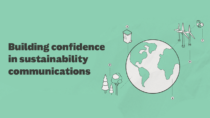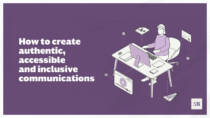Start here: the THRIVE methodology for stronger workplace cultures
By Sally Pritchett
CEO
Discover our THRIVE methodology - a practical way to build a stronger workplace culture through communication.
When it comes to the workplace, culture is one of those words that gets thrown around as though it’s a fixed thing. Something you can define, measure or simply create on demand. It’s often treated like a destination you reach once you’ve ticked enough boxes or invested in the right initiatives.
But culture is complex, fluid, multi layered and requires continual focus. Creating a positive, trusted workplace culture can take years to build and days to break down. The Dutch have a great phrase for this – ‘trust comes in on foot but leaves on horseback.’
The challenge for People and HR teams, often the ones expected to drive culture, is where to start. As the lowest funded support team in many organisations*, they’re often chronically under-resourced. Their remit is broad – spanning DEIB, wellbeing, employee experience and employer brand development. Not to mention navigating change, hybrid working, the widening gap between frontline and knowledge workers, connecting employees to organisational purpose, driving volunteering and social impact… the list goes on and on.
With so many competing priorities – and the need to keep culture alive every day – where do you even start?
Culture change isn’t a switch. It’s a system.
Culture isn’t something that sits on a to-do list. It isn’t built in workshops. It’s shaped every day by how people feel, how decisions are made and how we communicate with the workforce. It’s systemic, intentional and the golden thread that runs through everything, holding the organisation together.
Creating that golden thread – that strategic narrative – is much harder than it looks.
As experts in elevating employee communication to drive positive cultures and create great places to work, we created our own framework and diagnostic approach. It helps organisations assess where they are today, so we can guide them towards the culture they want to build.
We call it THRIVE because we believe everyone deserves to thrive. And because we know that when our people thrive, so does the business.
THRIVE focuses on six interconnected pillars that shape employees’ everyday experience of work:
- Talent – Attracting, developing and retaining people through authentic, honest and engaging employer brands.
- Human – Creating a human culture that sees employees as people not resources, genuinely appreciating their contribution, caring for their wellbeing and giving them a genuine voice.
- Roadmap – Clearly and consistently communicating the organisations’ strategic narrative, direction and purpose in a way that inspires so everyone knows where they’re going, why it matters and how they can contribute.
- Inclusion – Building a sense of inclusion and belonging that enables everyone to come on the journey, bringing their true and best selves to work. Ensuring every voice is heard, valued and respected.
- Values – Having clearly defined and communicated values that are lived and respected by all and consistently used to drive decision making and guide direction
- Experience – Designing touchpoints and narratives that shape the moments that matter throughout the journey from candidate to alumni.
If you’re on a journey to improving workplace culture, or you’ve just joined an organisation and want a clear picture of where things stand, explore our methodology here and talk to us about our diagnostic approach.
How to focus campaigns with a single-minded proposition
By Sally Pritchett
CEO
Campaigns fail when they try to do too much. The best ones focus on one clear idea.
If your campaign is trying to say everything, chances are it’s saying nothing. When you’re passionate about your product or service, it’s tempting to shout about every feature, benefit and value all at once. But when you try to say too much, your message gets lost. The most effective campaigns have one thing in common: they focus on just one thing. And that’s where the single-minded proposition (SMP) comes in.
What is a single-minded proposition?
At its core, a single-minded proposition is the one thing you want your audience to remember. It’s the golden thread that ties everything in your campaign together. Not a list of benefits. Not a product feature. Just one clear, compelling reason for your audience to care.
Think of it as the engine of your campaign. Without it, the campaign doesn’t move. You might have all the creative assets – the shiny visuals, the clever copy, the right channels – but without a strong SMP driving it, your message risks going nowhere.
Why it matters
Without a clear SMP, campaigns can easily lose focus. Teams pull in different directions, creatives interpret briefs in their own ways, and the result is often a fragmented message that fails to land.
A well-crafted SMP keeps everyone aligned – from strategy through to execution. It ensures consistency across all touchpoints, making sure that your campaign speaks with one voice, no matter where or how your audience encounters it.
What makes a good SMP?
A strong single-minded proposition doesn’t just come from knowing your product. It comes from knowing your audience.
It starts with truth. What’s the human insight or emotional hook that connects your audience to your message? Forget the long list of product features – what do people really care about? What problem are you solving? What emotion are you tapping into?
For example, Persil’s Dirt is good changed the conversation around laundry. It didn’t focus on stain removal or cleaning power. Instead, it connected with parents on an emotional level – helping them see that getting dirty was part of their child’s growth. Tesco’s Every little helps cut through a crowded market by focusing on small, meaningful savings.
These aren’t product features. They’re simple, emotive ideas that speak to something deeper.
Tips for crafting your SMP
Now that you know what a single-minded proposition is, how do you actually create one that sticks? Here are some practical tips to help you get started.
- Start with truth – What’s the real insight about your audience or the world they live in? Ground your message in that reality.
- Go emotional – People remember how you made them feel. Find the hook that resonates on a human level.
- Be ruthless – Focus on one thing. Not two. Not three. Just one. It’s harder than it sounds.
- Stress test it – Does it make sense across different channels? Can your team, your client, your creative lead all align behind it?
- Don’t confuse it with a headline – A strong SMP might become the campaign’s headline, but that’s not the goal. The SMP is there to guide the creative, not replace it.
Common traps to avoid
One of the biggest pitfalls when creating a campaign is trying to say everything at once. The more you cram in -features, benefits, values – the more likely your message will get lost. Instead of standing out, it blends into the noise.
Another trap is confusing features with meaning. It’s easy to focus on what your product does – like free delivery or 24/7 support – but that’s not what makes people care. A strong single-minded proposition goes deeper. It connects with why those features matter to your audience and what difference they make in their lives.
One message, one shared focus
The beauty of a single-minded proposition is that it gives everyone – strategists, creatives, stakeholders – a shared focus. It keeps campaigns sharp and aligned. And in a world where attention is fleeting, that focus can make all the difference.
If you’ve ever struggled to pin down what your campaign is really trying to say, or if your message has felt lost in the noise, it’s time to rethink your approach.
Because when it comes to cutting through, one thing done well is always better than ten things done half-heartedly.
Need help finding that one thing your audience really cares about?
We work with businesses to develop laser-focused campaigns built around a strong single-minded proposition – cutting through the noise and landing messages that stick. If you’re ready to sharpen your focus, we’re here to help.
Watch the webinar
Staying focused: The power of a single minded proposition
Guide: Building confidence in sustainability communications
By Sally Pritchett
CEO
Your shortcut to confident, compelling and trustworthy sustainability comms.
Sustainability comms is one of the hardest things to get right.
Say too little, and people won’t know about all the great work you’re doing. Say too much, and you could risk being accused of greenwashing. The stakes are high, but the opportunity is huge – when you get it right, you build trust, inspire action and create real change.
This guide is here to help you do exactly that.
Whether you’re a communications professional tasked with telling the sustainability story – or a sustainability lead trying to get people to listen – this practical manual is designed to help you communicate with clarity, honesty and impact.
What’s inside:
- Why sustainability comms is uniquely challenging – and how to overcome the common traps
- How to communicate honestly without greenwashing – or greenhushing
- Tips for choosing the right words, tone and visuals
- Insights on how different generations engage with the topic of sustainability
- Real-world examples, do’s and don’ts and easy wins you can start using right away
- Cut through the noise. Say what matters. And say it in a way people trust.
Download the manual and start building confidence in your sustainability comms.
Download here
We’ve created two accessible versions of the manual – light and dark mode – both optimised for screen readers. Choose the one that works best for you. Need help? Just drop us a line at hello@somethingbig.co.uk.
PDF version
A PDF that can be read by a screen reader
Dark mode PDF
A PDF in dark mode, that can be read by a screen reader
Workplace communication as a catalyst for inclusion and racial equity
By Sally Pritchett
CEO
Discover how intentional communication can drive real inclusion and racial equity in your workplace.
To mark the International Day for the Elimination of Racial Discrimination, in partnership with Race Excellence we hosted a powerful conversation exploring how communication can drive inclusion and racial equity in the workplace.
The session offered valuable insights into the role communication plays in creating fairer, more inclusive environments – where everyone feels heard, respected, and empowered.
Here are some of the key takeaways:
Make space for timely conversations
Having open, honest conversations at the right time matters. When significant events happen – globally or within your own organisation – your team are affected. Proactive communication helps people feel supported and creates space for reflection, empathy, and action.
Bring the right voices into the room
Involving senior leaders, subject matter experts, and individuals who can influence others ensures conversations lead to action. To create meaningful change, the right people need to be in the room – especially those with the authority to make decisions.
Prioritise active listening
Sometimes the most powerful part of a conversation is the silence. Good communication isn’t just about what you say – it’s also about how well you listen. Give people space to think. Avoid jumping in with answers. Create opportunities for reflection and let quieter voices be heard.
Choose your channels carefully
Communication isn’t one-size-fits-all. Consider how best to reach your audience – whether it’s workshops, one-to-ones, shared documents, or live conversations. Be thoughtful about the tools and platforms you use.
Keep your messaging clear and constructive
Whether you’re talking about policy change, allyship or team culture, everyone should leave the conversation knowing what comes next. Avoid jargon, lead with clear questions and make sure conversations end with actions.
Maintain respect
Respect should sit at the heart of every conversation. Even when opinions differ, it’s possible to challenge constructively and keep doors open. Communication that focuses on shared goals, solutions and unity is far more effective than blame or defensiveness.
Communication shapes inclusion
Words matter, so when language is restricted or policed, the impact can be exclusion, disconnection, and fractured identities. In many workplaces, race is still seen as too complex or risky to talk about – leading to silence, self-censorship, and missed opportunities to understand each other.
Communication done well, though, can flip that script. It can become a tool for liberation – making space for lived experiences, validating identity, and giving employees permission to bring their full selves to work. Inclusion doesn’t come from silence, it comes from stories, language, and meaningful dialogue.
Telling isn’t enough
Workplace communication often defaults to telling – issuing updates, sharing top-down messaging, or rolling out policies. But simply telling people what to do or believe isn’t enough to create change. It can even do more harm than good if it overlooks how people are really feeling.
To make a real impact, communication needs to do more than inform. It needs to listen, educate, inspire, and reassure. It needs to raise awareness in a way that connects with people’s emotions – not just their inboxes. It needs to make space for difficult conversations, reflection, and vulnerability.
Say the thing. Don’t dodge it.
One of the biggest communication challenges in DEI is avoiding “the elephant in the room.” Whether it’s a disbanded ERG, a delayed strategy, or an external event that’s affecting your teams, silence creates space for mistrust and disengagement.
Filling that silence with open, honest, human communication – even when the message is tough – builds credibility and trust. Employees are adults. Treating them as such by being transparent about decisions, even when there’s no perfect solution, goes a long way.
Surface the human library
Your organisation is full of unseen stories. These lived experiences are powerful, personal, and valuable. When people share them, they create connection, understanding, and culture change. But those stories don’t surface on their own. You need to make space for them, and ensure people feel safe and supported to speak up.
Culture and communication go hand in hand
If you want honest conversations, you need a culture that supports them. That means:
- Being clear on the purpose of conversations
- Making sure the right people are in the room – especially those with decision-making power
- Building psychological safety so people feel confident to speak up
- Leading with questions, not assumptions
- Ending with action, so people know what’s changing and why
When we use communication intentionally, we create momentum. When we pair that communication with inclusive culture, we create change.
We’d like to thank Ann and Gifford from Race Excellence for sharing their insight. Race Excellence partners with organisations to embed diversity, equity, inclusion and belonging into the heart of their business – supporting CEOs, Boards, employee networks and HR leaders to take a sustainable and innovative approach to inclusion. Learn more about Race Excellence.
If you’re looking for support with harnessing the power of communication to create a more equitable workplace, then talk to us.
Watch the webinar: Communications – a catalyst for inclusion and racial equity
The key trends shaping happy and high-performing teams
By Sally Pritchett
CEO
What does it take to build a workplace where happiness fuels high performance?
What does it take to build a workplace where happiness fuels high performance?
To celebrate B Corp Month, our CEO, Sally Pritchett, joined a panel of B Corp leaders and industry experts at Uncommon Holborn to explore just that. In conversation with Bleddyn Harris, Head of People and Culture at B Lab, the discussion revealed key trends shaping the future of work and what businesses can do to create thriving, engaged teams.
Rethinking workplace culture
Too many businesses are still stuck in an outdated industrial mindset – viewing employees as cogs in a machine that need to be optimised and replaced when they break. But workplaces are ever-evolving living ecosystems, filled with diverse identities, ideas and experiences.
To create a culture where employees thrive, businesses must:
- Listen deeply – go beyond surveys to understand the real undercurrents shaping employee experience.
- Make change an engaging process – design change communications to be creative, inspiring and participatory.
- Enable flow states – consider how workspace design, communication styles and celebrations contribute to culture.
- Embrace conscious leadership – leaders should create a positive and collaborative environment where everyone can thrive.
Tackling loneliness
Loneliness has become a big and unfortunate trending topic, but it is important to know that it is not caused by remote work – it’s caused by fractured cultures. Return to office mandates are part of the loneliness problem; what could be lonelier than feeling disconnected from your colleagues while sitting in a buzzy office? Communication plays a vital role in bridging that gap.
Valuing feedback
Surveys, suggestion boxes and employee groups may seem like standard tools – but they only work when they are inclusive and transparent.
Key principles of effective feedback include:
- Providing multiple ways to contribute – recognising potential language and other barriers, offering different ways to feedback.
- Appointing spokespeople – ensuring non-native speakers and those not comfortable with speaking up can have a voice.
- Creating a genuine feedback loop – sharing all survey results, addressing difficult feedback and being honest when changes aren’t possible.
- Targeting disengagement – where you are seeing signs of disengagement, for example low survey response rates, investigate the cause. Would tailored training or perhaps surveys in multiple languages or formats help?
Communicating through change
During times of change, clarity and consistency are everything. Strong leadership voices, regular updates and a visible presence – with an example given of a CEO spending time working from reception – can create a sense of stability.
Humans are natural storytellers. If leaders don’t shape the narrative, employees will create their own – and that’s where misinformation can spread. Tapping into the stories that drive purpose fuels both innovation and productivity.
Creating human-centric work environments
A desk and chair are no longer enough. The spaces we work in play a crucial role in collaboration, focus and connection. The venue itself, Uncommon’s Holborn location, is a perfect example of how human-centric design, greenery and calming aesthetics can enhance workplace wellbeing.
Modern workplaces need to provide flexibility, offering spaces that support both deep work and collaboration. Thoughtful design can create an environment that facilitates productivity and meaningful interactions.
Supporting volunteering programmes
Businesses offering paid volunteering days is on the rise, but offering the benefit doesn’t automatically result in take-up – businesses need to actively encourage participation.
Volunteering isn’t just good for the individual – it strengthens engagement, productivity and workplace culture. It tackles loneliness, builds community and enhances wellbeing. The key is making it easy for employees to get involved.
Want to see how we helped a client inspire over 120,000 employees to volunteer? Find out more here.
Overcoming communication overload
Communication tools like video calls and instant messaging were meant to streamline work. Instead, they’ve created a culture of constant communication – where employees are drowning in notifications, meetings and distractions. The workplace is now like a crowded room where everyone is talking at once. It’s affecting productivity, wellbeing and relationships. To fix this, businesses must:
- Set clear communication guidelines – establish expectations for response times and message urgency.
- Encourage mindful communication – leaders should model concise, purposeful messaging.
- Reduce unnecessary noise – assess which platforms are essential and eliminate redundant ones.
Communication: the key to workplace happiness and performance
At the heart of all these trends lies communication. Getting it right means understanding what, when and how to communicate – ensuring efficiency without overload. Talk to your teams, listen to what they need and create a workplace where communication fuels success rather than hinders it.
A happy, high-performing team isn’t built overnight. But with purposeful communication, inclusive culture and thoughtful leadership, businesses can create environments where people truly thrive.
At Something Big, we help businesses communicate with clarity, creativity and inclusivity – making workplaces fairer, healthier and happier. From shaping strategy and change programmes to fostering wellbeing and inclusion, we work with some of the world’s best workplaces to engage leaders, managers and frontline teams through impactful communication.
Ready to build a thriving workplace? Let’s talk.
Crafting clear, accessible, and visually impactful corporate reports
By Sally Pritchett
CEO
What makes a corporate report truly stand out? How can businesses share their progress in a way that’s clear, accessible, and trustworthy?
What makes a corporate report truly stand out? How can businesses share their progress in a way that’s clear, accessible, and trustworthy?
A great corporate report needs to do so much more than just tick a box – it should build trust, inspire action, and drive progress. Whether it’s for employees, customers, shareholders, or the wider world, a well-crafted report strengthens credibility and showcases meaningful change.
From gender pay gap to sustainability disclosures, from annual to impact, all reports should be about more than just compliance. In an era of increasing scrutiny around corporate responsibility, effective reporting has never been more important.
But too often, reports become dense, jargon-heavy documents that fail to connect with their audiences. So how can businesses make their reports clear, accessible, and meaningful?
Why good reporting matters
At their best, reports bring clarity and confidence to a business’s progress. They help organisations communicate with employees, customers, investors, and wider stakeholders in a way that feels transparent and authentic. A strong report shows where improvements are needed, creating a sense of accountability that builds long-term trust.
Good reporting also plays a role in shaping wider industry standards. When businesses openly share their progress, and challenges, it encourages others to do the same. It fosters innovation, sets benchmarks for best practice, and drives collective action on issues like sustainability, inclusion, and responsible business.
What makes a corporate report effective?
At Something Big, our years of experience in crafting award-winning corporate reports has taught us that be effective, reports must be:
- Engaging. A great report tells a story. It uses clear, compelling language and visuals that bring data to life.
- Accessible. Inclusivity matters. From clear language to digital-first formats, reports should be easy to understand, navigate and accessible.
- Accountable. Transparency is key. A strong report includes honest reflections, clear metrics, and measurable outcomes, avoiding vague claims or jargon.
Avoiding common pitfalls
Despite the best intentions, many corporate reports fall into familiar traps. One of the most common is corporate washing – where businesses overstate their efforts or use vague language to appear more responsible than they are. Whether it’s greenwashing in sustainability reporting or purpose-washing in impact reports, this not only damages trust but can also lead to legal and reputational risks.
On the other hand, some organisations take the opposite approach, holding back on sharing progress for fear of scrutiny. While caution is understandable, under-communicating achievements can mean missing opportunities to engage stakeholders, build credibility, and drive change.
Another common issue is information overload. A report should inform, not overwhelm. Too much jargon, excessive data, or a lack of clear structure can make it difficult for readers to extract key insights. Striking the right balance between depth and clarity is essential.
Five tips for clear and credible reports
If you’re looking to create a report that resonates, consider these five key principles:
- Be transparent – Clarity and honesty build trust. Be upfront about both successes and areas for improvement.
- Make it accessible – Ensure your report is easy to read, navigate, and understand for diverse audiences.
- Use storytelling – Facts and figures are important, but a strong narrative helps connect with people on a deeper level.
- Focus on action – Reports shouldn’t just reflect on the past—they should provide a clear vision for the future.
- Invest in design – A well-designed report enhances engagement, making key information more digestible and impactful.
Need help with your reporting?
We’re experts in helping businesses create reports that are clear, impactful, and trustworthy. Whether it’s an annual report, a comprehensive ESG update, an impact report, D&I disclosure, or any other type of reporting, we help businesses balance transparency with impact – showcasing achievements and ensuring clarity without overcomplicating the message. Find out more about our report design services here.
See More:
How to Create Clear, Credible, and Impactful Corporate Reports
What makes a corporate report stand out? How can businesses share progress in a way that’s clear, accessible, and trustworthy? In this 30-minute webinar, we explore how high-quality reporting builds trust, inspires action, and drives progress for employees, stakeholders, and the planet.
How to create cost-effective agency partnerships
By Sally Pritchett
CEO
Learn how to keep project costs under control with practical tips for building cost-effective agency partnerships.
Learn how to keep project costs under control with practical tips for building cost-effective agency partnerships.
Whether you’re planning a global campaign or tackling a one-off project, managing budgets effectively is key to maximizing value. With the right approach, you can avoid unnecessary costs while still achieving impactful results.
Building an effective partnership with your agency starts with clear communication, well-defined expectations, and mutual trust. But even with the best intentions, budgets can creep up in unexpected ways. Understanding these challenges and knowing how to address them will empower you to get the most out of your agency relationships.
When projects go wrong: five common ways costs can creep up
Even the most well-planned projects can run into trouble if certain issues aren’t addressed early. Here are some of the most common ways budgets can spiral out of control and how to spot them:
- Unplanned changes: Stakeholders providing feedback late or in an uncoordinated way can lead to inefficiencies. Try to consolidate feedback before sharing it with your agency.
- Last-minute tweaks: Even small changes late in the process can ripple across multiple deliverables, inflating costs. Ensure content is accurate before design work begins.
- Unclear briefs: A shifting or vague brief can create confusion and lead to additional rounds of revisions. Align on scope and objectives upfront to avoid misunderstandings.
- Scope creep: Requests for “just one more thing” often snowball into costly additions. Include a contingency budget to handle unexpected tweaks without derailing timelines.
- Tight timelines: It’s easy to run out of time and not realise that last minute decisions can impact budgets, but limited time often leads to higher costs from out of hours working or more expensive delivery options.
Our top tips for making the most of your agency budget
Once you’ve identified the potential pitfalls, the next step is setting yourself up for success. These practical tips will help you make the most of your agency partnership while keeping costs under control:
- Communicate clearly: Have verbal briefings as well as written ones, to ensure alignment and minimise misunderstandings. A strong start sets the foundation for success.
- Define roles early: Be clear about what tasks your team will handle internally and where you need your agency’s expertise. This ensures resources are used effectively.
- Plan timelines carefully: Allow sufficient time to avoid the higher costs associated with rush jobs.
- Set aside a contingency budget: Plan for unforeseen challenges to maintain flexibility and keep the project on track.
- Be clear on who your stakeholders are: Identify what level of input each stakeholder will have and when their feedback will be required.
- Streamline feedback: Ensure your feedback is aligned and consolidated from all stakeholders, where possible, to avoid additional rounds of amends which could be out of scope.
By focusing on clear communication, thoughtful planning, and proactive collaboration, you can build a cost-effective partnership with your agency that delivers impactful results. And if you’re looking for an experienced agency partner with over 25 years of expertise working with complex global organisations – we’re here to help.
See More:
How to Work with Agencies (And Get Amazing Results)
Are you new to the marketing and communications industry? Agencies can be the secret to levelling up your career fast, but understanding the art of collaborating with them is essential. In this video, we give you the tools to build strong agency partnerships.
Guide: How to create authentic, accessible and inclusive communications
By Sally Pritchett
CEO
Discover how to create communications that connect with audiences through authentic, accessible, and inclusive messaging in this essential guide.
Inclusive, accessible, and authentic communication has the power to connect, inspire, and drive meaningful change. This manual, How to Create Authentic, Accessible, and Inclusive Communications, is an essential resource for anyone striving to create messaging that resonates with diverse audiences and delivers real impact.
Packed with insights, guidance, and actionable tips, this guide will help you ensure your work is inclusive, accessible, and authentically representative. Whether you’re looking to deepen your understanding, refine your communication approach, or start embedding inclusion into your processes, this manual provides the tools and inspiration you need.
In this manual you’ll discover:
- Why inclusivity in communications matters and how it drives connection and impact.
- What inclusive communications should look and feel like with practical examples.
- How to foster diversity and authentic representation while avoiding tokenism.
- Practical tips for accessibility making sure your communications reach everyone.
- Advice on using AI ethically to support inclusivity and authenticity.
- How to build an inclusive mindset and embrace continuous improvement
Download the guide now and start creating communications that inspire change, connect with audiences, and make a lasting difference.
Choose the right version for you
We’ve created several versions of the manual, each with different accessibility features. Please choose the option that works best for you. If you need assistance navigating these options, don’t hesitate to get in touch with us hello@somethingbig.co.uk.
PDF version
A PDF that can be read out by a screen reader
Dark mode PDF
A PDF in dark mode, that can be read out by a screen reader
Audio PDF
A PDF with the option to be read aloud by an AI voiceover
Video audio
A video of the manual, read by an AI voiceover
Green Monday 2025: Catch up on the sessions
By Sally Pritchett
CEO
Planning your next Green Monday? Find the latest line up and resources here.
Green Monday was a big success!
We said goodbye to Blue Monday – the so-called “most depressing day of the year” – and had a day dedicated to positivity and sustainability.
Together, we NetWalked, tackled the biggest challenges to business change, discussed how to bring stakeholders along the sustainability journey, and explored the power of impactful reporting. And a big thank you to our speakers for their thought-provoking contributions, and to everyone who walked, listened, shared, and connected.
Catch up on Green Monday
Breaking down the 3 big obstacles in business change
Discover how communications can help overcome the common challenges to change and sustain momentum through the ups and downs.
Bringing your stakeholders on the sustainability journey
Learn how to engage employees, customers, investors, and communities with authentic ESG communications.
Creating clear and credible corporate reports
Explore how impactful reporting can build trust, inspire action, and showcase meaningful progress.
Your sustainability story deserves to be told
See how we can help you create beautifully designed reports that inform and inspire your stakeholders while driving meaningful progress.
Creating cultures of neuroinclusion
By Sally Pritchett
CEO
Discover how fostering neuroinclusion in the workplace can build an environment where all employees thrive.
Discover how fostering neuroinclusion in the workplace can build an environment where all employees thrive.
Diversity of thought and minds can bring fresh perspectives and innovative ideas. According to Deloitte, “organisations that make an extra effort to recruit, retain, and nurture neurodivergent workers can gain a competitive edge from increased diversity in skills, ways of thinking, and approaches to problem-solving”. With an estimated 15-20% of adults being neurodivergent, businesses that fail to support neurodiverse individuals risk falling behind. It’s essential for businesses to support the neurodivergent community by making necessary accommodations for everyone, regardless of diagnosis.
We were delighted to have Becs Tridgell from Autism Unlimited join us for our most recent ‘Tune In’, session, where we tuned into the voices of the neurodivergent community, looking to learn practical steps and strategies to foster a neuroinclusive workplace culture that values and supports every employee.
Watch the video below for a full recap, and check out the session highlights and key insights below:
The benefits of a neuroinclusive workforce
Neurodivergent employees bring unique strengths that can transform workplaces. Skills like hyper-focus, creative thinking, innovative problem-solving, empathy, and detailed analysis are just a few examples of the value neurodivergent individuals can offer when supported effectively.
However, these strengths can only thrive when workplaces address the challenges neurodivergent employees face. By fostering a culture of neuroinclusion, organisations unlock not only individual potential but also greater collaboration, loyalty, and long-term success.
Common challenges faced by neurodivergent employees
Many neurodivergent employees encounter significant barriers in the workplace. Traditional recruitment processes, such as interviews that emphasise eye contact or sociability, often overlook the strengths of neurodivergent candidates.
Masking – where individuals consciously or unconsciously hide their neurodivergent traits to appear more “typical” – is another challenge. While masking can help individuals fit into workplaces that may not be inclusive, it often leads to exhaustion, burnout, and reduced engagement.
Sensory sensitivities, like difficulties with noise, lighting, or smells, can also make everyday tasks unnecessarily difficult. For example, an open-plan office might create challenges for someone with auditory sensitivities, reducing their ability to focus or perform at their best.
The power of effective communication
Communication is a cornerstone of neuroinclusion. By prioritising clarity, consistency, and compassion, organisations can create an environment where neurodivergent employees feel understood, supported, and empowered.
Clarity
Clear communication ensures that everyone, regardless of neurotype, can engage fully. This includes:
- Sending agendas in advance of meetings
- Chunking information into smaller, manageable parts
- Using visual aids to support verbal explanations
- Providing assistive technologies
Consistency
Consistency builds trust and reliability. Neurodivergent employees often thrive in environments where expectations and processes are supported and made clear. Examples include:
- Assigning a buddy to new employees for ongoing support
- Standardising accommodations, like offering quiet spaces or noise-cancelling headphones
- Implementing policies to create sensory-friendly environments, such as discouraging strong smells in open-plan offices
Compassion
Compassionate communication acknowledges individual needs and ensures everyone feels valued. Tailored adjustments might include:
- Allowing regular breaks for employees who need to manage energy levels
- Providing specific ergonomic tools, like supportive chairs or coloured overlays
- Offering flexibility in how tasks are completed, enabling employees to work in ways that suit their strengths
Practical steps to build a neuroinclusive workplace
Neuroinclusion requires thoughtful, tailored adjustments that enable everyone to thrive, not just the neurodivergent.
Some practical steps include:
- Rethinking job design: Tailor roles to individual strengths rather than expecting everyone to fit into rigid job descriptions.
- Creating dedicated quiet spaces: Offer areas where employees can decompress or work in silence.
- Normalising accommodations: Provide tools like noise-cancelling headphones, visual aids, or flexible schedules to support productivity.
- Improving recruitment processes: Redesign interviews to focus on practical skills rather than sociability or traditional cues like eye contact.
- Fostering a supportive culture: Encourage open dialogue about neurodiversity to reduce stigma and build trust, ensuring employees feel safe to share their needs.
While supporting neurodivergent employees is both a legal and moral obligation – it’s a strategic advantage too. Through education, adjustments, and open dialogue, we can create workplaces where every mind is valued, and every employee can thrive.
If you need support on your journey to building a more neuroinclusive working environment, we’re here to help. Whether it’s developing culture change programmes, creating communication campaigns that drive inclusion, or ensuring your communications are accessible to all, we can provide the expertise you need. Talk to us today to start making a meaningful difference in your workplace.
Webinar: Empowering workforces to be neuroinclusive










